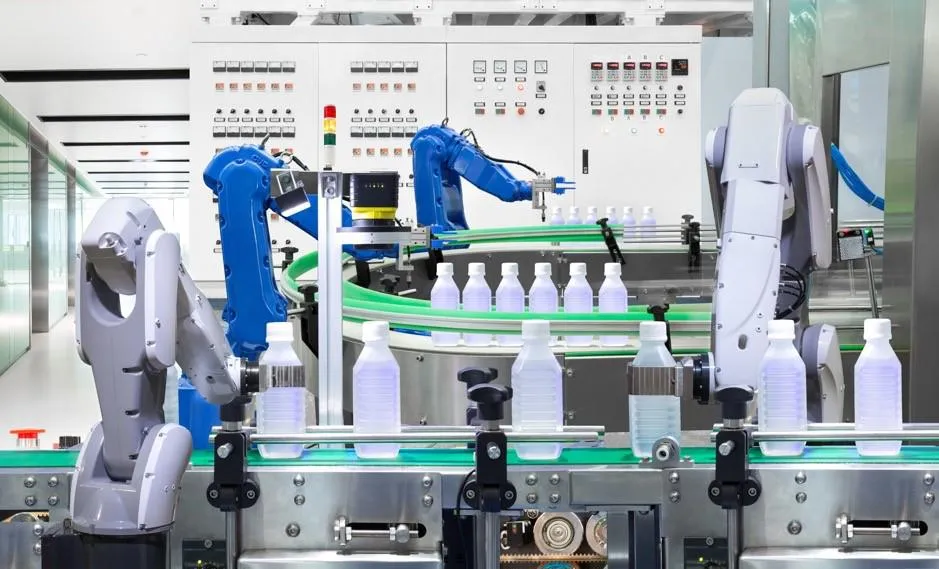We are in the middle of an industrial revolution.
The technology and ideas that underpin Industry 4.0 are transforming the way that manufacturers operate, and providing the insight and information required to build safe, sustainable production facilities which can keep up with current and future demand.
Despite this fact, many manufacturers, still utilise processes and procedures that are traditional, often manual, and ripe for improvement – perhaps because of a perception of the size and scale of change required to adopt an Industry 4.0-enabled approach.
In this blog, we speak to Adem Kulauzovic, Director of Coding Automation at Domino, to highlight how starting small can help build efficiencies for the future, and provide specific examples of areas where manufacturers can already utilise Industry 4.0 to address common and costly production issues, and improve production line efficiency.
Getting started
Industry 4.0 and IoT are great for introducing new and innovative methods into the manufacturing process, but at the start, the key is to start simple and build incrementally upon success.
“Don’t try to run before you can walk,” says Kulauzovic. “Start small, identify some quick wins, and meanwhile start to plan out which areas of your production line you want to focus the on.”
It is easy to get blown away by the many features Industry 4.0 has to offer – but there is no point investing in technology you will not use.
“Start by identifying where you have the largest or the most glaring issue,” says Kulauzovic. “Then work to implement a solution that can help you overcome this.”
Example 1: Streamlining product changeovers
Inefficient product changeovers are one of the main causes of downtime on production lines – downtime which can soon add up to a significant loss in capital.
“We were approached recently by a Domino customer to help with exactly this,” says Kulauzovic. “The customer, a large producer of spice mixes, was taking up to half an hour to change the webbing on their lines when switching to a new production run.”
The time taken to carry out a changeover can be reduced by ensuring that production workers are prepared ahead of time. This requires little more than a monitoring solution set up to provide a real-time product count, with a corresponding alert to let production staff know when a production run is coming to an end.
“For the spice manufacturers, we utilised QuickDesign, Domino’s coding automation software, to monitor the printers and send an automated alert when a production run was 15 minutes before completion – this allowed production staff to wheel in and prepare the spice webbing ahead of time.
“This is a really simple change – but it allowed the customer to reduce their changeover time from 30 minutes down to just 15. This enabled them to do two extra runs per day, which was huge – it effectively eliminated a whole shift of overtime.”
Example 2: Limiting manual data entry
Worldwide, operator error is one of the top causes of labelling mistakes – which, if unnoticed, can cause costly product recalls. Even if caught early, the cost resulting from an incorrect code, in terms of rework and wasted stock, can soon add up.
“Some customers reported having to stop lines on a very regular basis because of an incorrect code,” says Kulauzovic. “This is a massive cause of downtime and excess production waste but is also very easy to correct without requiring significant changes to production processes.”
Simple automated solutions can replace the need for manual data entry on production lines – for example, a barcode scanner can be utilised to populate product labels automatically based on an existing production order. Or, with another simple application of IoT technology, printers can be set up to populate label templates automatically from a central database.
To simplify further, in a facility with multiple production lines, a coding automation software such as Domino’s QuickDesign allows production line staff to network printers together,–and then automatically populate product label data from a central location, like a production office.
“Simple solutions can have a dramatic effect on the overall productivity of a production facility,” says Kulauzovic. “We have had customers report that up to 30% of production downtime has been due to coding errors – by removing the need for manual data entry, this can be reduced to 0%. That’s a lot of extra production capacity per year, without any extra man hours.”
RELATED: Stop the Touches: How to Eliminate Labelling Mistakes from Your Production Line

Example 3: Improving reporting
On traditional production lines machines often work in siloes, with monitoring and reporting left up to production floor teams. When issues arise, reporting of the root cause may not always point to the real issue.
This was the case recently with one Domino customer, who reported an issue with their case coder. The customer could not network the machines on their production line, and as such all issues were recorded manually on a clipboard.
Based on the logs written by the operator, the case coder was the cause of a significant percentage of the company’s wasted stock and unplanned downtime with the reason marked as “machine down due to poor code”. Upon visiting the site, a Domino technician discovered that the root cause of the error was a case erector malfunctioning, which in turn meant the coder was not printing in the right position.
Integrating line machinery with coding automation software can provide greater visibility of how a production line is operating – helping manufacturers to identify where errors are arising. This can improve reporting, allowing manufacturers to understand what improvements need to be implemented to increase production line efficiency and correct causes of downtime.
With Domino QuickDesign, this can be taken a step further to produce production reports providing accurate, non-biased information on production line performance. By utilising industry standards, and integrating into existing SCADA or SAP systems, QuickDesign can access production data from across production lines to generate reports based on print counts, rejection rates, product changeovers, and time shifts.
Example 4: Realising the benefits of integration
“The two main words I think of when I think of Industry 4.0 are ‘integration’ and ‘connectivity’,” says Kulauzovic. “This new revolution isn’t about new technology – it’s about making the most of the technology that already exists.”
By allowing machinery and systems to work together, manufacturers can significantly improve their production capabilities. For example, integrating machinery with an existing ERP or MES system via coding automation software can offer opportunities to automate product changeovers and production schedules.
Domino printers can be integrated with existing planning systems via Domino’s QuickDesign software to autonomously retrieve and distribute product information to multiple printers located across a production facility. The software retrieves instructions from an MES or ERP system and utilises the information to get the right code onto the right product at the right time.
This is particularly beneficial in industries requiring variable data printing for regulatory compliance – such as pharmaceuticals, medical devices, and horticulture (e.g. the new ‘Plant Passport’).
Empower your workforce
In his book, The Fourth Industrial Revolution, Professor Klaus Schwab, Founder and Executive Chairman of the World Economic Forum, called for leaders, and citizens to work together to “shape a future that works for all by putting people first, empowering them and constantly reminding ourselves that all of these new technologies are first and foremost tools made by people for people.”
Within any discussion of Industry 4.0, it is hard to escape the argument that greater automation will lead to the replacement of manual workers with machines – this argument is misleading and ignores the many opportunities that greater automation has to offer.
Traditional production lines can be stressful places to work. High pressure, fast-paced, and prone to error. With Industry 4.0, you can take away some of the stress of manual production work – allowing your workers to make more productive use of their time.
To take data entry as an example – this may be one of a whole list of duties that the average production worker will have in their day-to-day job role. A small, somewhat tedious job, that the average operative will be happy to see eliminated from their list of responsibilities.
“Industry 4.0 is not about replacing manual workers with machines,” says Kulauzovic, “It’s about reinventing production lines so that they are more efficient, and so that workers are focused where they matter most – which isn’t in carrying out menial production tasks.”
At its heart, Industry 4.0 holds the potential for more qualitative enrichment of factory work – providing operatives with a more interesting working environment, greater autonomy over workplace tasks, and, crucially, opportunities for self-development within the workplace.
Introducing new systems and process can present opportunities for workers to retrain, or specialise in new areas, to enable them to make better use of the analytics that come from coding automation.
“Alongside building a factory of the future, manufacturers should work towards creating a culture of employees with the skills and experience to make efficient use of the opportunities that Industry 4.0 has to offer,” says Kulauzovic.

Continue the journey
We have established that Industry 4.0 is not an ‘all or nothing’ commitment – there are stages of progression that manufacturers pursue, and aspects of Industry 4.0 that can be utilised to increase production line efficiency, without fully automating all aspects of production. As we’ve seen, it is possible to ‘start small’ and deliver genuine performance improvements.
“A lot of people learn more about their industry or their factory when they start utilising Industry 4.0,” says Kulauzovic. “When you start obtaining key data about a production facility, problems that have traditionally gone unnoticed start to become more obvious.”
By automating simple processes and utilising the production data that Industry 4.0 and coding automation have to offer, manufacturers can develop a better understanding of their production lines and realise the additional benefits that further automation may bring.
The key thing with Industry 4.0 is to start by addressing the small issues that all add up to a big impact. By overcoming production bottlenecks, manufacturers can increase efficiency and obtain more information about their production processes, this can pave the way for more creative solutions in the future.
If you would like to find out more about the benefits that coding automation could bring to your product lines, please get in touch. Our industry experts are on hand to discuss your specific requirements and support you, wherever you are in your Industry 4.0 journey.
Talk to the experts to find out how you can build your factory of the future, today.